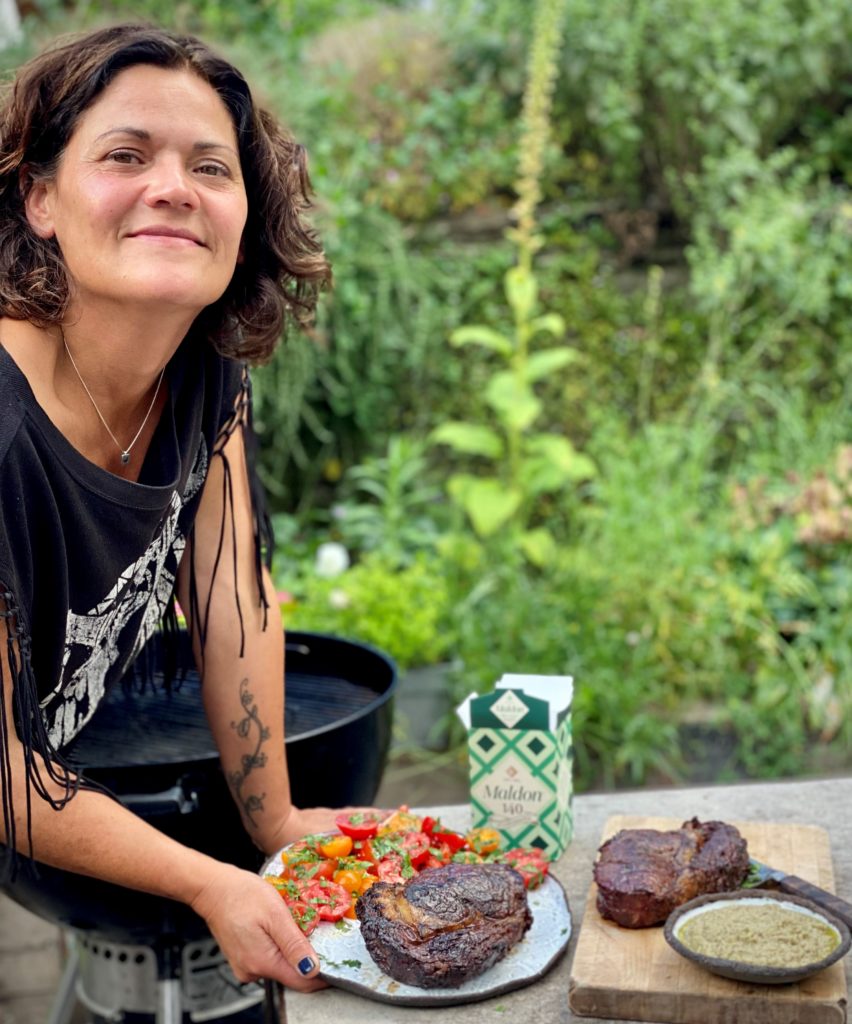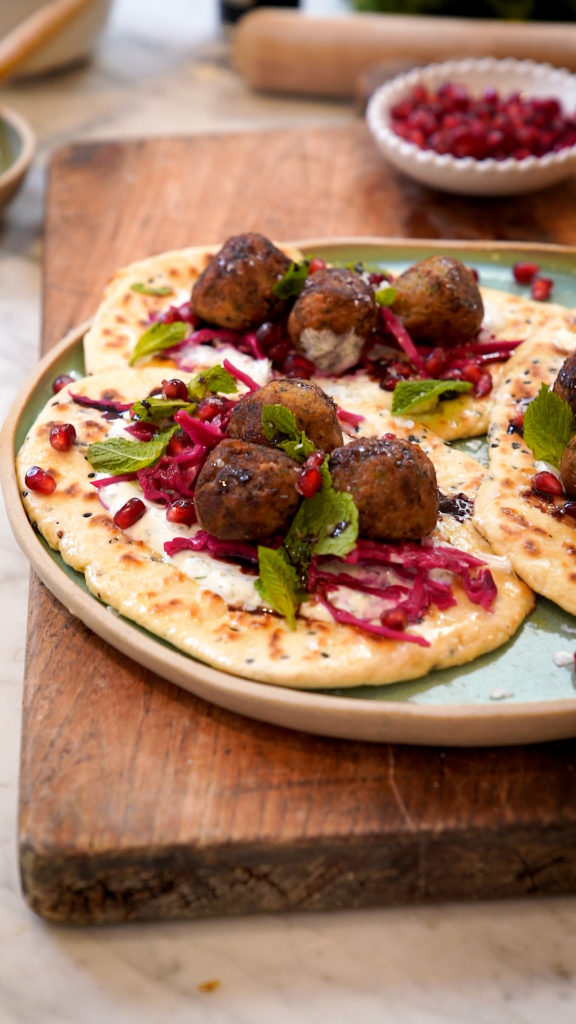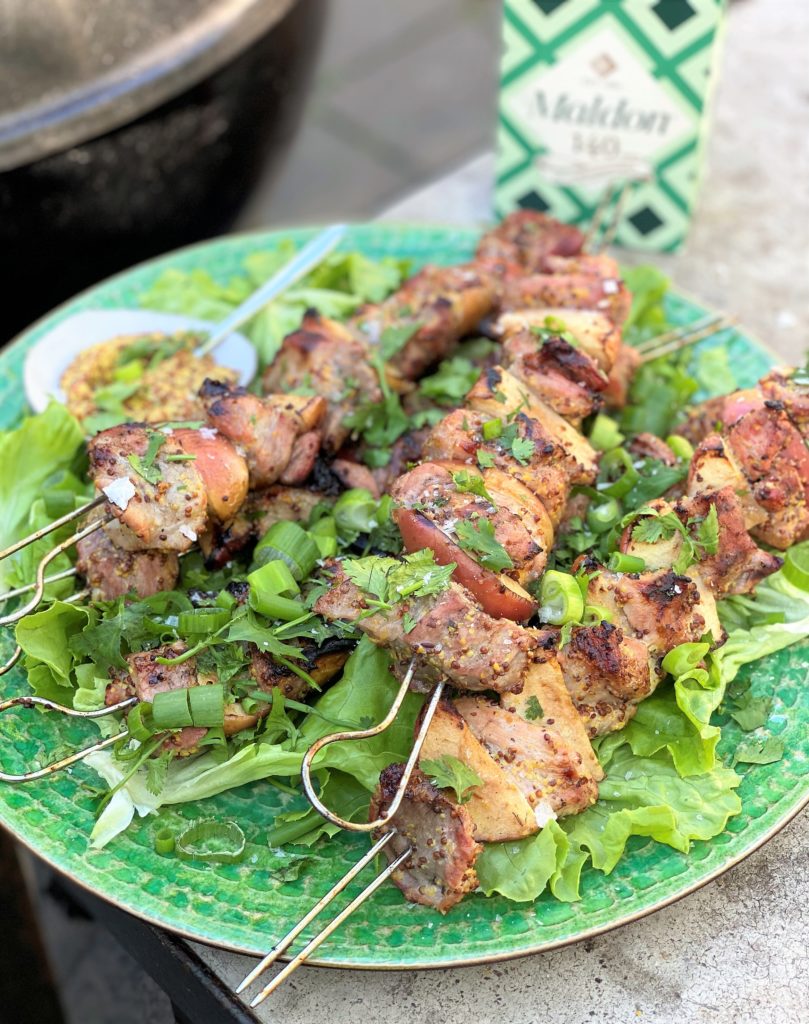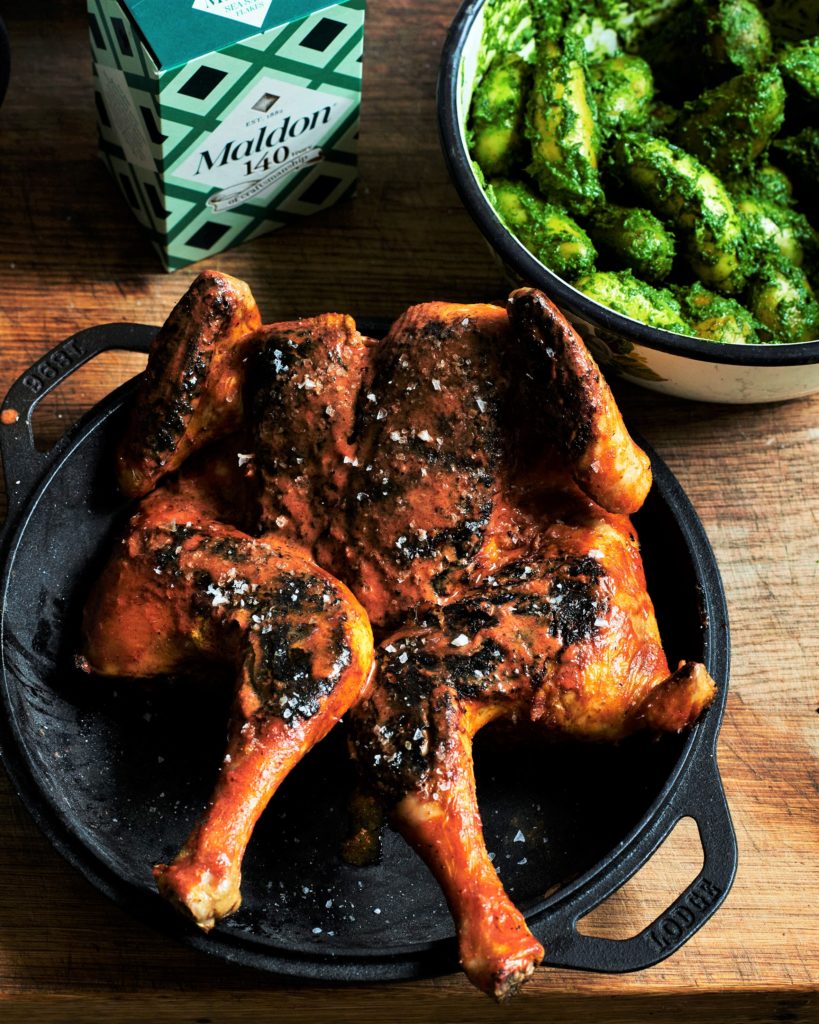Start this recipe the day before you want to eat as the steak needs overnight brining. Up to 24 hours ahead is fine. You can also cook this steak in the oven and on the hob if you don’t have access to a barbecue.
When it comes to cooking the steak, you apply the same principles as below, but take the low part of the cooking in the oven – around 100C in a fan oven for as long as it takes to get to the temperature you are looking for. See the numbers you need within the recipe. The sear part can happen in a very very hot frying pan, just flipping and turning to get maximum Maillard reactions until it is cooked how you like to eat it. Again, whether to rest or not is a personal preference.
- Begin by dry-brining the ribeyes. Please do it, it really makes the biggest difference (see more detail on why below) . Simply sprinkle Maldon Salt over both sides of the steaks, place on a rack set over a tray and slide into the fridge for 12-24 hours. The rack allows the air to circulate so the steak doesn’t swim in its own juices. Allow a good tablespoon or so of Maldon Salt per kilo of meat. Don’t cover the tray, you want the surface to dry out a little but do make sure the tray is on the bottom shelf of the fridge and not touching any other food.
- When you are ready to cook, fire up your barbecue ready for slow indirect cooking, aiming for a gentle temperature of around 120°C.
- Set the steak, always straight from the fridge, onto the grill bars far away from the fire, and shut the lid. Cook using very gentle convection heat, take the steak up to a temperature 10°C below the temperature you want to eat it at. A temperature probe is essential here. No need to turn or rotate, just let it very gently do its thing. It will look dry and unappetising at this point, never fear. The drying of the surface is going to work in your favour, allowing for the Maillard crust to build up during the sear.
- Whilst the steak is having the low and slow treatment, get everything else ready.
- To make the walnut and tarragon pesto, tip the walnuts into a small fireproof frying pan and toast over a medium heat on the hob for a couple of minutes. Add to a food processor along with the tarragon, garlic, olive oil and white wine vinegar and blend to a smooth paste. Season to taste with Maldon Salt and freshly ground black pepper and scoop into a bowl. Set aside.
- Prepare the salad by chopping up the tomatoes and dividing onto a plates or a serving platter. Scatter over herbs and drizzle with a really generous glug of extra virgin olive oil. Season well with sprinkles of Maldon Salt to taste. Set aside at room temperature for maximum flavour.
- Back to the steak – once it’s reached your chosen temperature you want get your barbecue really good and hot, so get those coals glowing red. I often start another little chimney of charcoal at this point if I feel it needs more heat. And get those bottom vents open wide – remember that more air means a hotter fire. Don’t worry about the top vents as you sear with the lid up.
- When your fire is hot, get the steak directly on the hot grill bars over the fire. Sear it hot and fast, flipping every 30 seconds or so with the lid up. Every time you turn, try to place it back on a slightly different bit of the grill bars to get maximum heat.
- Once the steak has a deep, mahogany brown crust on both sides and has reached your desired eating temperature, get it off and slice up to share, serving the salad and pesto alongside.
Top Tips By Genevieve Taylor:
Brining is the number one trick to boost meat tenderness
Salt is amazing: a little water-soluble molecule (sodium chloride or NaCl if you’re a bit of a science nerd like me) that has the ability to amplify the flavour of everything. Salt makes things taste better – your roast pork more porky, your ribeye steak more beefy or your curry more deliciously spicy – but it also has rather more miraculous properties than just enhancing flavour.
All meat benefits from the application of salt to increase juiciness and I have got into the habit of salting, or brining, all my meat before I cook it, regardless of the cut or species. It is, however, especially effective when you want to cook the perfect steak. Good steak is a treat and it really pays to cook it as well as you can.
With dry-brining, when you sprinkle salt over meat it quickly draws out a little water from the muscle cells, creating a really concentrated salty brine on the surface. Over time this salty brine soaks back into the meat by a process called diffusion. Nature always wants to seek equilibrium – so the more salty outside diffuses into the less salty inside, doing its darnedest to make things equal. When you salt meat, it physically breaks the protein bonds that hold the muscle cells together in a tight bundle so over time the tight bundle becomes a much looser bundle. By disrupting the bonds between muscle fibres they cannot physically contract up as much once that meat hits the heat, so less of the water inside gets squeezed out. The result? Juicer meat with the flavour ramped up to the max.
How to dry-brine
Dry-brining is ridiculously easy and quick. Simply sprinkle Maldon Salt all over the meat and set the onto a rack hung over a tray, slide into the fridge, uncovered, and leave undisturbed while the salt does it magic. The rack allows air to circulate and prevents the meat from resting in its own juices. A rough rule of thumb is to use a level tablespoon of Maldon Salt per kilo of meat. I try to leave the meat brining for 12-24 hours as standard, but even a couple of hours is worth doing if you are short of time. There’s no need to wash the salt off after brining. In fact I would encourage you not to as the salt will have slightly dried out the surface and a dry surface results in more effective Maillard reactions.
Maillard reaction, and why we don’t want perfect grill bar marks
The Maillard, or browning, reaction is a chemical chain reaction sequence that creates hundreds of new flavour molecules. It is why steak with a glorious crisply seared crust will always taste infinitely better than steak that is floppy, pale and grey-looking. While we may have been led to believe that perfect grill bar marks on our steak are the end goal, if evidence of the Maillard reactions is shown by browning on the surface, it almost goes without saying that grill marks are 100% not the aim here. You are only allowing the browning reaction to happen where the marks are, all the unmarked bits don’t get the insane flavour boost Maillard gives you. The more browning, the more flavour and an evenly browned crusty outer is the goal rather than the neat parallel lines mirroring your grill bars. Constant turning and flipping your steaks over a very high heat is the way to get an even crust.
Why reverse sear?
I prefer to cook thick steaks to share; it’s easier to nail the internal temperature vs crust conundrum, i.e. max sear on the outside, minimal chance of overcooking the inside. And I like the spirit of generosity it’s served in; a sharing dish always feels like a more friendly way of eating, offering an edible gift to those I love. Sharing steaks are always best cooked used a brilliantly failsafe technique called ‘reverse sear’. The weight of steak is irrelevant as you are cooking to temperature and so this technique is identical whether you are cooking a 500-600g steak for two or a 1-1.2kg steak for four. You do need an instant read thermometer, such as a Thermapen, for this technique but they are such useful things for all meat cooking I think they are a worthwhile investment.
With the reverse sear technique you flip the traditional way of cooking steak on its head, so instead of searing hot and fast, then moving to a cooler spot to finish cooking, you start very cool and finish very, very hot indeed. The result is a steak cooked to equal perfection from the outside to the centre, with a glorious deep brown crust all over.
Heat energy from the fire of your barbecue excites the molecules on the outside of the steak and those molecules transfer the heat into the centre of the meat. By starting your cook very slowly that heat transfer happens evenly, so your steak will be the exact same temperature on the outside as it is in the middle. Call it the fire cook’s equivalent of sous vide, if you like. The danger with starting high and finishing cooler is that you overdo the outside while trying to get the inside done as you like it, so the outside layer of a steak can be dry and overcooked. Reverse sear gives you, the cook, the chance for gentle equilibrium from top to bottom, resulting in a juicer steak with a better crust.
What temperature to cook to?
Ribeye steaks have a generous nugget of tasty fat in the centre, and whilst I like rare steak, the ribeye is a good cut to take a little further, perhaps to medium rare or medium to render the fat melting and succulent. But by all means eat it rare if you prefer.
With the reverse sear method you cook the steak low and slow to 10C below the final eating temperature, then to sear it very hot and fast until you have the temperature you want to eat it at.
Follow these temperatures when cooking:
- Rare – cook to 42C low and slow, then take to 52C with a hot and fast sear
- Medium rare – 46c initially, then 56C to eat
- Medium – 50C followed by 60C
Why I don’t bother to rest steak
I always prefer to cook steak to the temperature I want to each it at and eat it as quickly as possible after getting it off the grill. The reason being that meat carries on cooking once off the heat and resting, but the rate of carryover cooking is rather variable – is it a hot summers day, or rather cool and chilly, or a humid damp day? These things have a big impact on carryover cooking meaning it can be impossible to judge when to remove it from the grill. The good news is, with dry brining, I guarantee your steak will be juicy and succulent straight from the grill.
For more on the science of how to cook meat over a fire, see my latest booked Seared: https://www.genevievetaylor.co.uk/store/Seared-The-Ultimate-Guide-to-Barbecuing-Meat-p430638630




